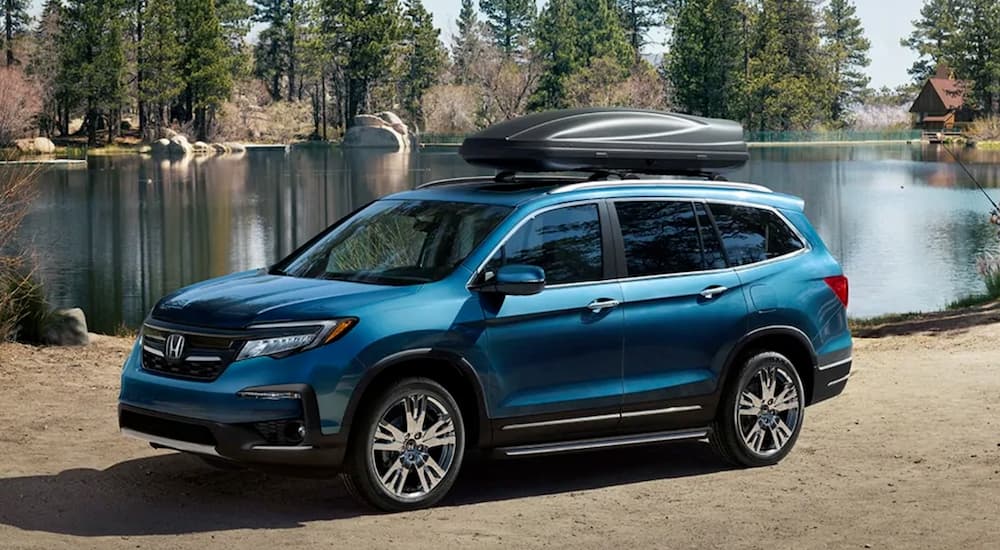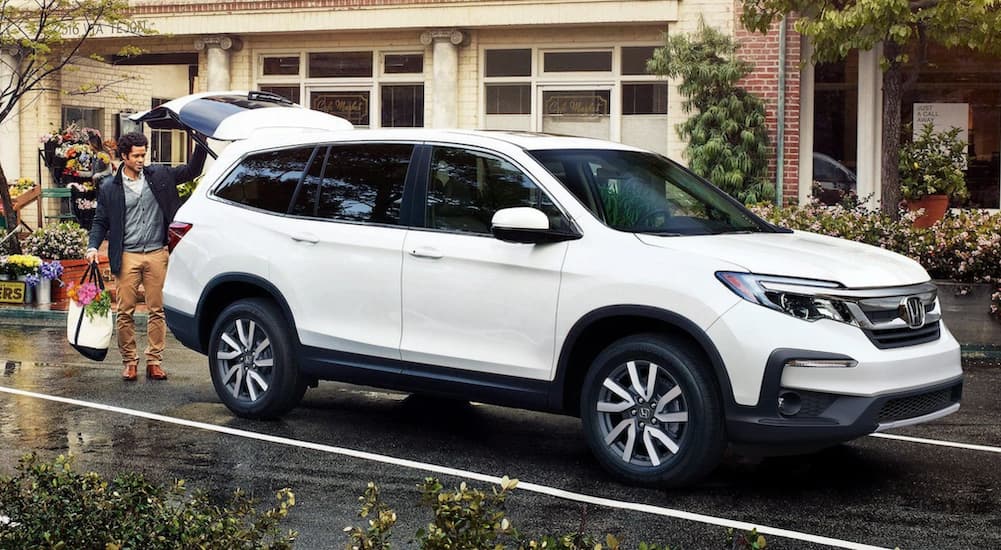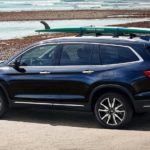Even in the hotly contested midsize SUV category, the Honda Pilot is a true standout. The three-row crossover has been recognized for its safety, performance, and resale value time and time again, with Honda’s stellar reputation for reliability helping the Pilot gain an edge in a crowded segment. With seating for up to eight, the Pilot is Honda’s largest SUV but shares many traits with some of Honda’s most popular models. For example, the SUV is built on the same platform as the best-selling Honda Accord, a solid sedan that was the country’s most popular vehicle from 2013 to 2015.
One step up from the Passport in the Honda lineup, the Pilot is the automaker’s most family-friendly model to date, with plenty of room for both passengers and cargo. As Honda prepares to unveil the fourth-generation model for 2023, we thought it would be the perfect time to look back on previous generations of the popular crossover for buyers seeking a used Honda Pilot for sale. We’ll trace some of the innovations that have kept the Pilot fresh over the years and see why, when it comes to comfort, reliability, and safety, there’s no beating the Honda Pilot.
The First Generation (2003-2008)
The first generation Honda Pilot is getting on in years at this point, and while we won’t devote too much time to these early models, they provide some important context for things to come. The original Honda Pilot played an important role in Honda’s SUV history, giving the automaker a midsize model that could compete with segment leaders like the Chevy Trailblazer and Ford Explorer. Prior to the debut of the Pilot, Honda’s only presence in the segment was the Honda Passport which, in actuality, was just a rebadged Isuzu Rodeo. Honda knew it needed a homebrewed contender to keep pace in the rapidly growing midsize market, and the Pilot was born.
Honda took a novel––and forward-thinking––approach when it came to the Pilot, opting to use unibody construction instead of the truck-like, body-on-frame design that was so popular at the time. This immediately set the Pilot apart from the competition, providing a smooth, more comfortable, and efficient ride that, within a decade, would become the norm within the SUV class. By bucking the body-on-frame trend, Honda paved the way for the coming crossover boom, a prescient move giving the automaker a distinct advantage moving forward.
The first-generation Pilot shared its platform with the Honda Accord sedan, Honda Odyssey minivan, and the Acura MDX luxury SUV but differentiated itself from the rest of the lineup with a design that included a peppy 2.5-liter, 244-horsepower V6 engine and all-wheel drive as a standard feature. Honda would roll out a front-wheel drive model with cylinder deactivation for fuel-conscious drivers in 2006. The Pilot was also designed with a wider body than most other midsize SUVs and could easily accommodate a 4×8 sheet of plywood with the seats folded down. This focus on functionality immediately caught the public’s attention, with the Pilot earning some die-hard fans right out of the gate.
The Second Generation (2009-2015)
With the second-generation Pilot, Honda took everything there was to love about the original model and kicked it up a notch. There were the expected design updates, with the SUV receiving a more rounded design with new headlights, sliding second-row seats, and an easily accessible hatch window in the tailgate leading the list of changes, but the spacious interior once again grabbed all the headlines. Honda elongated the wheelbase on the crossover by an additional 2.9 inches, increasing the cargo space to 18 cubic feet all the way up to 87 cubic feet with the seats folded. To put this into context, that’s enough room to fit a go-kart, which one reviewer actually managed to do in testing.
Honda dropped a new 3.5-liter V6 into the second-gen Pilot, giving drivers 250 horsepower to play with while still managing to stay competitive in terms of fuel economy. As other automakers began to embrace the crossover trend for their own midsize SUV offerings, the Pilot still retained an edge over many of its truck-based competitors with an EPA-estimated fuel economy rating of 17 MPG in the city and 23 highway for front-wheel drive models and 16 MPG in the city and 22 MPG on the highway for those equipped with all-wheel drive (though this does vary by year). This was accomplished in part thanks to Honda’s Variable Cylinder Management (VCM) system, an evolution of the cylinder deactivation technology that made earlier front-wheel drive Pilot models so thrifty at the pump.
Another area where the Pilot continued to make strides was safety. The Pilot had long been one of the segment’s most well-reviewed models in terms of safety, but Honda wasn’t content to rest on its laurels, integrating new cutting-edge safety tech that went a long way in maintaining the brand’s reputation. The SUV received glowing reviews from the Insurance Institute for Highway Safety (IIHS) and National Highway Traffic Safety Administration (NHTSA) thanks in no small part to the inclusion of Honda’s new Advanced Compatibility Engineering front bracket.
The innovative body design allowed the Pilot to evenly distribute energy during a collision, directing it away from the passengers while also reducing the damage to other vehicles. This was accomplished through the use of different grades of steel throughout the frame, which enabled the vehicle to crumple in some areas while remaining rigid elsewhere. The technology allowed the Pilot to achieve some of the industry’s lowest fatality ratings in tests by the IIHS, and Honda further strengthened the SUV’s safety portfolio in 2013 by making a rear-view backup camera a standard feature.
Some earlier versions of the second-gen Pilot might be starting to show their age, but thanks to Honda’s reputation for reliability, there are still plenty of great deals to be found when shopping the used market. The crossover received a design overhaul in 2012, so those seeking a more modern-looking model should look into models produced in the latter half of the second-generation run. These models also include many of the entertainment-focused tech features drivers now take for granted, such as Bluetooth compatibility and a touchscreen infotainment screen.
The Third Generation (2016-2022)
That brings us to the most recent generation of the Honda Pilot, which first hit the road back in 2016. The new era brought a sleeker appearance to the popular SUV, which, in addition to giving the Pilot a more contemporary look, also had some functional benefits when it came to reducing drag. The third-generation Pilot is able to navigate the road with ten percent less drag than its predecessor, giving it improved fuel economy over previous models and upping its efficiency stats to an EPA-estimated 20 MPG in the city and 27 MPG on the highway for front-wheel drive models and 19 MPG in the city and 26 MPG on the highway with all-wheel drive. It’s not only the aerodynamic design that helped the Pilot up its fuel economy numbers: the new Pilot is also 309 pounds lighter than second-gen models thanks to the use of new frame materials. These same materials, which include ultra-high-strength steels, aluminum, magnesium, and mild-strength steel, also reduce the Pilot’s noise, vibration, and harshness while keeping repair costs low in comparison to other SUV models.
The Pilot continues to make strides when it comes to the engine, with an upgraded 3.5-liter V6 now offering some 280 horsepower. Combine this with the Pilot’s lighter weight, and you’ve got an energetic, responsive ride that can speed from zero to 60 in just 6.1 seconds––a 1.5-second improvement over previous versions. An advanced traction management system allows the family-focused SUV to hold its own in mild off-road scenarios with specialized settings for snow, mud, and other challenging surfaces, but it’s the Pilot suite of advanced safety features that truly set the third-gen Pilot apart.
The Honda Sensing package includes all the advanced driving assistance systems (ADAS) drivers have come to expect, from forward-collision warning and emergency braking to lane-keeping assist, adaptive cruise control, and more. In addition to the basic package, drivers have a long list of safety-focused add-ons to choose from, like rear cross-traffic alert, lane-departure warning, and LaneWatch, which uses a small camera mounted below the right passenger-side mirror to provide a live blind spot monitoring feed to the Pilot’s central infotainment display screen.
As always, the third-generation Pilot excels when it comes to interior space. The crossover has 16.5-18.5 cubic feet of cargo space when all the seats are upright, but that increases to 46.8-55.9 cubic feet all the way up to 83.9-109 cubic feet with the third and second rows folded. Further increasing interior comfort is a long list of features that include three-zone air conditioning, a power driver’s seat, leather seating, a power liftgate, a rear-seat entertainment system, a moonroof, a heated steering wheel, heated second-row captain’s chairs, and a 540-watt premium audio system on upper trims. The Pilot received a modest mid-cycle refresh in 2019 that saw some design changes––new bumpers, grille, wheels, standard LED headlights, and revised tail lights––as well as an improved transmission and infotainment system with the Honda Sensing package also becoming standard across all trims.
A Trailblazing Three-Row SUV
The Honda Pilot has long been a trailblazer in the midsize SUV class, leading the way when it comes to size, safety, and innovation. This reputation stretches all the way back to the Pilot’s early years when Honda bucked the body-on-frame trend to bring one of the industry’s first crossover designs to the segment. Honda has raised the bar time and time again when it comes to the Pilot, integrating many cutting-edge features while ignoring the flash-in-the-pans trends that can become so quickly dated. The approach has paid dividends for Honda, with the Pilot continually being recognized as a leader in the segment, and we expect the future to hold much of the same as the automaker prepares to unveil the fourth-generation Pilot for the 2023 model year. While a new version is on the way, it’s a great time to explore used models.





